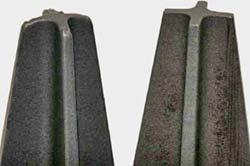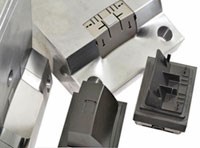How Trends in Diesinking EDM are Benefiting Moldmakers
Turnkey solutions that provide automation in a more affordable and easy-to-implement package are available for today’s mold manufacturers.
Despite the current economic climate moldmakers who take advantage of the latest technological innovations will continue to have a significant edge up on the competition. Indeed, the shrinking levels of demand for many products have, to some degree, increased the amount of benefit derived from new technologies.
Productivity Gains
Many moldmakers have discovered that remaining profitable requires running 24/7. As a result, automation has become increasingly important to the industry. A majority of moldmakers now implement some form of automation to maximize productivity, but many of these solutions have been built in a piecemeal fashion, with machines, pallet changers or robots all coming from different sources. While such systems can work extremely well, they may create an extremely complex situation as upgrades and maintenance are required.
Additionally, when each component is designed specifically to complement the other components it will be partnered with, a much greater level of efficiency can be attained and maintenance is managed by a single source.
Productivity gains also can be found through the high levels of accuracy attained by new technologies in diesinking EDM. Thermostabilization has become very sophisticated in recent years. Today, machines can be purchased that contain pulsed air systems that circulate cooled air within the cabin, adjusting its temperature as needed by using probes to monitor the temperature of the dielectric. Similar systems maintain temperature stability through the frame of the machine and dielectric fluid is circulated through the work table to prevent thermal shocks while filling the tank. By eliminating the impact of temperature fluctuations, the positioning of electrodes relative to workpieces becomes even more accurate and may allow for faster cutting speeds due to perfect alignment from one electrode to the next.
Diesinking EDM Technology
While automation and accuracy technologies have made and are continuing to make significant progress, some of today’s most impressive innovations are taking place in the realm of spark generation and control. Tremendous strides have been made in improving the energy efficiency of diesinking EDM technology. When many manufacturers think of the term energy efficiency, their monthly electricity bill comes to mind. In this context, though, it also refers to the amount of energy that goes into the spark generated by the EDM, as opposed to the energy that is lost during discharge. As less energy is wasted, the cutting speed and wear improves dramatically.
Machining with no electrode wear has been a goal of EDM manufacturers for decades. Most frequently, machine builders and users would attempt to manipulate machine settings to eliminate wear, typically at the cost of much slower cutting speeds. Early on, these efforts would fail due to the use of mechanical transistors that inevitably cause electrical drains. As EDM evolved and superior technology was created, electrode wear could be greatly reduced, but this required cutting at speeds so slow that it proved inefficient in real-world applications.
The creation and implementation of field programmable gate arrays (FPGAs) allowed EDM generators to make a substantial step toward reducing electrode wear by providing for much better control of the spark. During EDM machining, a spark discharge occurs right as voltage begins to drop and current picks up. As resistance between the electrode and workpiece breaks down, a plasma channel grows and then the spark is discharged. FPGAs allow the exact timing of that event to be controlled to billionths of a second.
The next step in spark control evolution comes from advanced software that greatly increases control over spark generation, resulting in 80 to 85 percent of the energy generated being used in the spark. Compared to the 8 to 50 percent attained by previous generations of EDM technology, this represents a significant improvement. By instigating this level of spark control, a much finer surface finish is produced, material is removed efficiently and electrode wear is dramatically reduced.
When machining four cavities that are each 80 mm deep, the advances of this technology become very visually apparent. As can be seen in Figure 1 much more substantial wear occurs on the electrode when the cavities are cut with a traditional generator. This results in the need for a second electrode to perform finishing operations, which costs both time and money.
A trident-shaped cavity can be seen in Figure 2. Machined in steel with a graphite electrode, the feature resulted in electrode wear of 468 µm with a machining time of 195 minutes when cut with standard die sinking technology. Using the latest spark control technology, machining time increased slightly to 207 minutes, but electrode wear dropped to just 5 µm. Obviously, the reduction in electrodes required to cut parts more than compensates for the relatively small increases in machining times.
The benefits of new generator technology become most apparent to those moldmakers producing complex components with intricate details. In some cases, these jobs require in excess of 40 electrodes to produce a single mold. If that number can be reduced by 25 to 40 percent with little increase in machining times, the potential for savings is tremendous.
Summary
While the economy continues to present hardships to manufacturers across the world, advances in technology provide a competitive advantage to those that embrace them. Additionally, those companies that adopt new technology to survive today will be well positioned to thrive when conditions turnaround and the market rebounds.
Related Content
6 Ways to Optimize High-Feed Milling
High-feed milling can significantly outweigh potential reliability challenges. Consider these six strategies in order to make high-feed milling successful for your business.
Read MoreSolving Mold Alignment Problems with the Right Alignment Lock
Correct alignment lock selection can reduce maintenance costs and molding downtime, as well as increase part quality over the mold’s entire life.
Read MoreIt Starts With the Part: A Plastic Part Checklist Ensures Good Mold Design
All successful mold build projects start with examining the part to be molded to ensure it is moldable and will meet the customers' production objectives.
Read MoreRead Next
Accuracy Determines Quality in Electrode Manufacturing
A look at how electrode accuracy directly impacts the overall value of the mold build process.
Read MoreAre You a Moldmaker Considering 3D Printing? Consider the 3D Printing Workshop at NPE2024
Presentations will cover 3D printing for mold tooling, material innovation, product development, bridge production and full-scale, high-volume additive manufacturing.
Read MoreReasons to Use Fiber Lasers for Mold Cleaning
Fiber lasers offer a simplicity, speed, control and portability, minimizing mold cleaning risks.
Read More
























